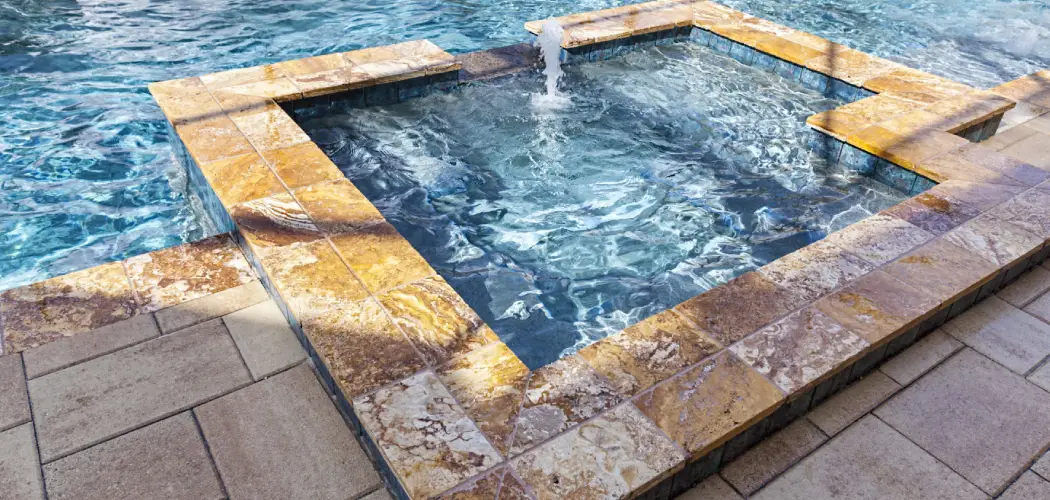Pool coping is an integral part of any pool’s design, providing structural support, visual appeal, and safety. Situated at the edge of the pool, coping acts as the capstone that shields the pool’s structure from water damage and enhances its overall aesthetics.
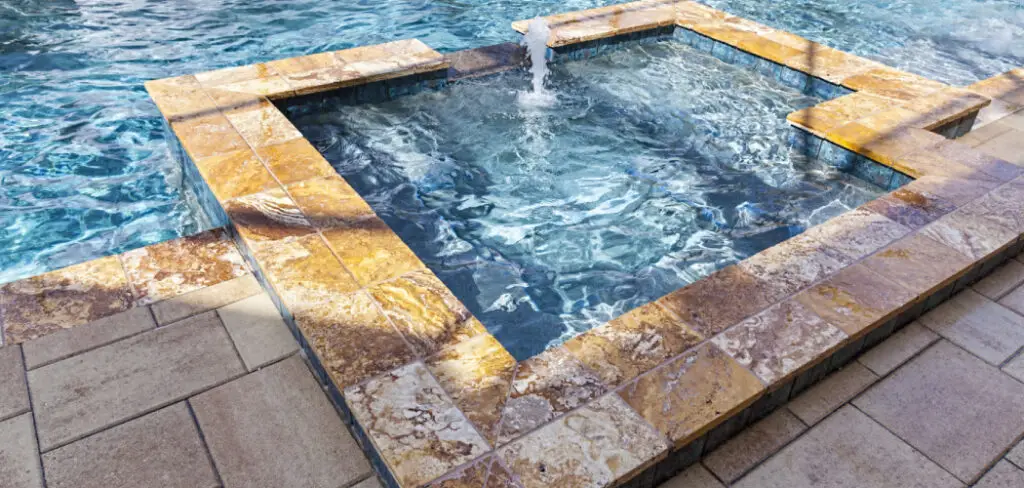
However, over time, exposure to dirt, pool chemicals, algae, and natural elements can compromise its appearance and functionality. Learning how to clean pool coping is essential for pool owners to maintain a pristine, safe, and long-lasting pool area.
This guide outlines step-by-step methods, practical tools, and expert tips for keeping pool coping spotless across various materials such as tile, stone, and concrete.
What is Pool Coping?
Pool coping refers to the material used to form the edge around the top perimeter of a swimming pool. While coping is stylish, it is also functional, acting as a barrier that protects the pool shell from water intrusion. Beyond that, it gives swimmers a sturdy edge to grip and provides a boundary that reduces slip hazards.
Types of Pool Coping Materials
Each type of pool coping has unique advantages, cleaning requirements, and challenges. Familiarizing yourself with the different materials ensures you use suitable cleaning methods.
- Tile Coping: Tiles are sleek, water-resistant, and relatively easy to clean, but they often gather residue like calcium buildup or grime over time.
- Stone Coping: Natural stones such as travertine or limestone provide an earthy, elegant aesthetic. However, their porous surfaces make them susceptible to stains, mold, and discoloration.
- Concrete Coping: Durable and affordable, concrete coping can withstand heavy wear but is prone to mildew and embedded grime because of its porous nature.
Common Challenges with Dirty Pool Coping
Exposure to pool chemicals, splashing water, and environmental debris often leads to a buildup on pool coping. Over time, untreated dirt accelerates the wear process and causes discoloration, weakening the material. Slippery algae and deeply embedded stains also increase risks for slips and aesthetic degradation.
Tools and Materials Needed to Clean Pool Coping
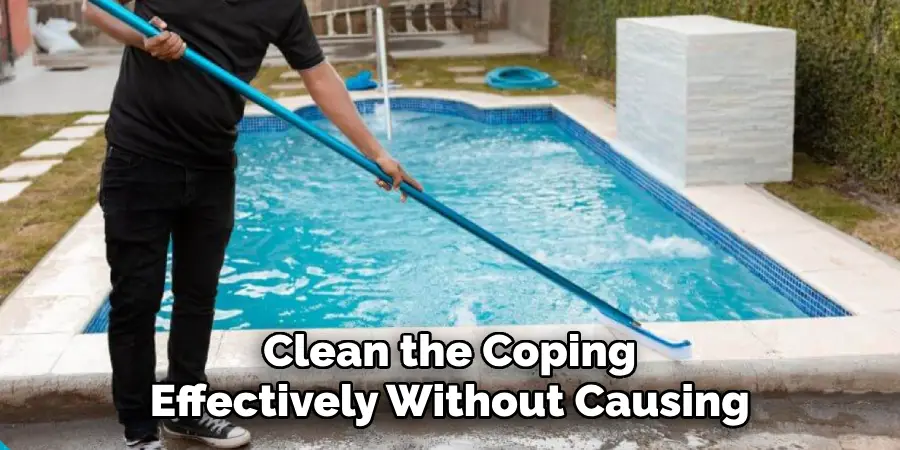
Proper cleaning of pool coping requires the right set of tools and cleaning solutions. Armed with the appropriate materials, you can clean the coping effectively without causing damage.
Essential Cleaning Tools
- Soft-Bristle Brush or Sponge: Effective for scrubbing grime or algae without scratching delicate materials.
- Pressure Washer: Ideal for durable materials like concrete and stone, but should be used with caution to avoid surface damage.
- Microfiber Towels: Helpful for buffing and drying, especially for polished stones or tiles.
- Buckets or Spray Bottles: Necessary for holding or dispensing cleaning solutions on the coping.
Cleaning Solutions for Pool Coping
Different cleaning agents work better for various coping materials:
- Mild Liquid Detergents: Safe for most materials and effective on surface-level dirt.
- Vinegar Solutions: A natural, eco-friendly option perfect for dealing with mildew or mineral deposits.
- Baking Soda Paste: Excellent for removing stubborn stains, especially on natural stone or concrete.
- Specialized Cleaners: Products designed for tile and stone are effective for tough stains like algae.
Essential Safety Gear
Cleaning pool coping involves water and chemicals that may cause accidents or irritation. Equip yourself with:
- Protective Gloves: To shield your skin from potentially harmful cleaners.
- Safety Goggles: To protect your eyes from cleaning sprays or debris.
- Non-Slip Shoes: Prevent slipping around the pool edge during the cleaning process.
Preparing the Pool Coping for Cleaning
Adequate preparation ensures cleaning efforts are effective and thorough. Follow these steps to prepare the pool coping for cleaning.
Lowering Pool Water Levels
For heavy cleaning tasks, such as removing algae or severe stains, slightly lowering the pool’s water level gives you better access to the coping. This step is particularly helpful when dealing with submerged dirt or algae near water-contact edges.
Clearing Surface Debris
Start by removing visible debris from the coping area. Use a broom or pool skimmer to sweep leaves, dirt, and twigs off the surface. Skipping this step could lead to unnecessary scratches while scrubbing or pressure washing.
How to Clean Pool Coping: Cleaning Methods
Tailoring your cleaning approach to suit each material ensures you maintain both the effectiveness of the cleaning and the integrity of the pool coping.
Cleaning Stone Coping
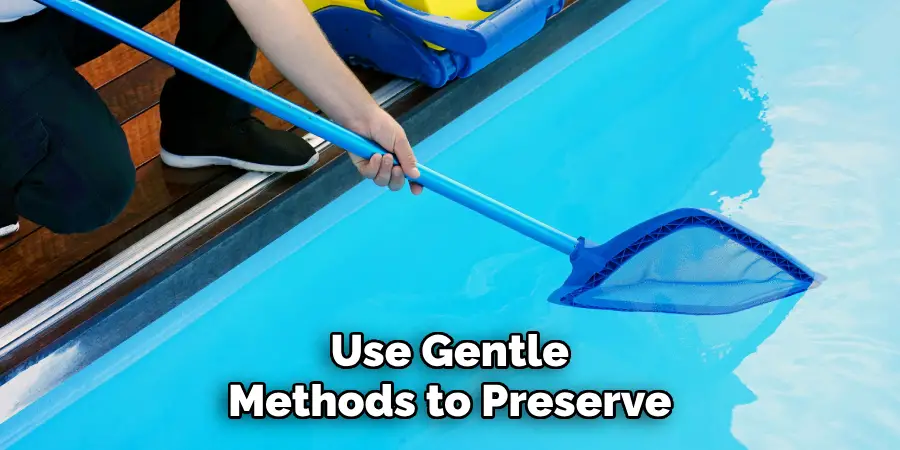
Natural stone coping, such as granite or travertine, is porous and can stain easily when cleaned improperly. Use gentle methods to preserve its natural charm.
- Create a Cleaning Solution: Mix a small amount of liquid detergent with warm water in a bucket.
- Scrub Gently: Use a soft-bristle brush to scrub the coping gently in circular motions, concentrating on stained areas.
- Rinse Thoroughly: Spray the coping surface with clean water to remove soap residue.
- Treat Stubborn Stains: Apply baking soda paste or a pH-neutral stone cleaner to difficult spots and repeat the scrubbing.
Tip: Avoid acidic solutions like vinegar on natural stone as these can cause etching or discoloration.
Cleaning Tile Coping
Tile coping requires frequent cleaning to avoid mineral buildup, which causes hazy spots and dulls its polished shine.
- Apply Vinegar Solution: Spray a mixture of equal parts vinegar and water onto the tile surface.
- Scrub Well: Use a sponge or soft cloth to wipe away dirt and deposits. Be gentle to avoid scratching the tiles.
- Buff for Shine: After rinsing, use a microfiber towel to dry and polish the tiles, restoring their luster.
Cleaning Concrete Coping
Although concrete is resilient, improper cleaning can lead to premature cracks or mold growth.
- Sweep or Rinse: Use a broom or hose to remove loose dirt or debris from the surface.
- Pressure Wash (Optional): Use a low-pressure setting to clean deeper grime without damaging the surface.
- Apply Cleaner: For stubborn stains, use a commercial concrete cleaner. Scrub thoroughly with a stiff-bristle brush.
- Finish With Sealing (Optional): After drying, consider applying a concrete sealant to prevent future stains.
Tip: Avoid using bleach, as it can weaken concrete over time.
Removing Tough Stains on Pool Coping
Tackling tough stains requires targeted techniques to preserve the material while removing blemishes.
- Rust Stains: Apply a specialized rust remover, leaving it on the spot for 15 minutes before scrubbing gently.
- Algae or Mold: Use an anti-algae cleaner and give it 10-20 minutes to break down slime layers before scrubbing.
- Chemical Residue: Baking soda paste works well for lifting persistent stains caused by excess pool chemicals.
Always perform a test patch with any cleaning agent to ensure compatibility with the coping material.
Preventive Maintenance for Pool Coping
Consistent upkeep means fewer deep-cleaning sessions and a longer lifespan for pool coping.
- Frequent Cleaning: Clean once every two weeks during heavy pool usage to prevent algae or dirt buildup.
- Apply Protective Sealants: Use sealants designed for specific materials to protect against water absorption, mold, or discoloration.
- Mindful Use Around Coping: Avoid dragging heavy or abrasive objects across coping edges to prevent scratches.
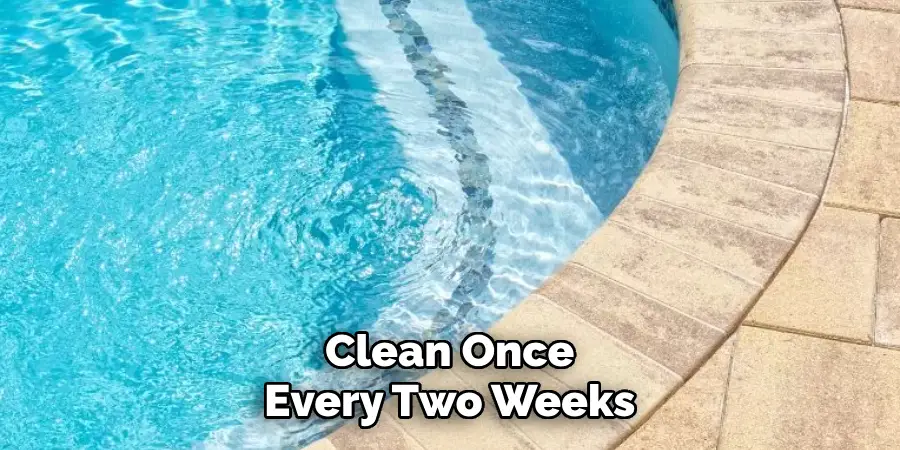
Common Mistakes to Avoid When Cleaning Pool Coping
Avoiding errors during cleaning ensures you maintain optimal results without damaging the materials.
- Using Abrasive Tools: Harsh scrubbing pads may cause scratches, particularly on stone or polished surfaces.
- Overusing Chemicals: Dilute cleaning agents as needed to reduce the risk of etching or weakening the material.
- Skipping Rinsing Steps: Residual cleaners can discolor or erode pool coping over time if not thoroughly rinsed away.
By avoiding these mistakes, you’ll protect your coping from unnecessary damage while enjoying top-notch results.
Benefits of Maintaining Clean Pool Coping
Regular coping maintenance enhances more than just aesthetics. Here’s how:
- Improved Pool Safety: Clean coping reduces slippery surfaces caused by mold and mildew. This helps prevent slip-and-fall accidents around the pool area, especially for children and elderly individuals.
- Prolonged Coping Lifespan: By keeping your coping clean, you reduce potential damage caused by dirt, debris, and chemicals. This prolongs its lifespan and minimizes the need for costly repairs or replacements.
- Enhanced Visual Appeal: Clean coping gives your pool a fresh look that adds to the overall visual appeal of your backyard oasis. It also creates a welcoming atmosphere for guests or potential buyers if you decide to sell your home in the future.
- Preserves Water Quality: When pool coping is well-maintained, it prevents contaminants from seeping into the pool. This helps to preserve the water quality and keep it safe for swimming.
- Increased Safety: Cracked or worn-down coping can create tripping hazards, especially for young children who may be running around the pool area. Regular cleaning and maintenance of your coping can help prevent accidents and promote a safer environment for swimmers.
FAQ’s About Pool Coping Maintenance
Why Is Pool Coping Maintenance Important?
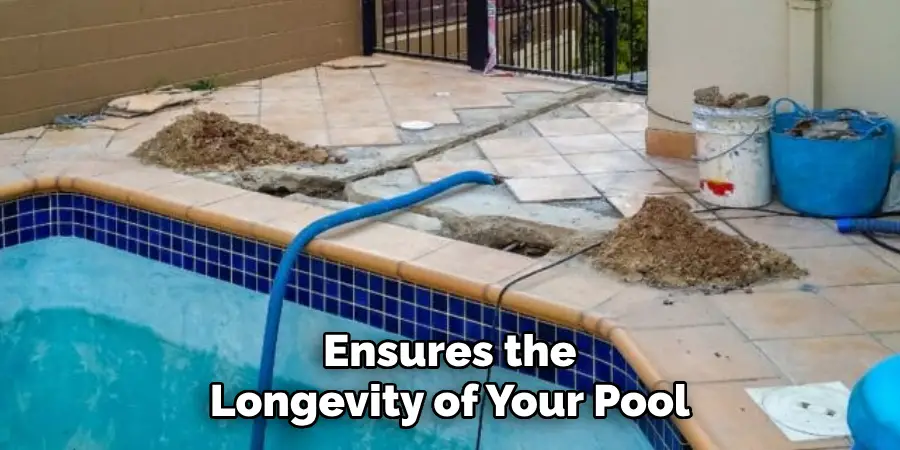
Regular maintenance ensures the longevity of your pool, prevents damage, and enhances safety. It also helps maintain the pool’s water quality and aesthetic appeal.
How Often Should Pool Coping Be Inspected?
It is recommended to inspect your pool coping at least once or twice a year, especially before and after swimming seasons, to catch and address any damage early.
What Are Common Signs That Pool Coping Needs Repairs?
Cracks, discoloration, loose tiles, or worn edges are clear signs that your pool coping may need repairs or maintenance.
Can I Perform Pool Coping Maintenance Myself?
While minor cleaning and repairs can be done yourself, it’s always best to consult a professional for more extensive issues to ensure proper results.
Is Pool Coping Maintenance Expensive?
The cost of maintenance can vary depending on the extent of work needed. However, regular upkeep is generally more cost-effective than paying for major repairs later.
Conclusion
Maintaining your pool coping is essential to keep your pool area safe, functional, and visually appealing. Regular inspections and proper care can prevent costly repairs and extend the life of your pool coping.
If you’re wondering how to clean pool coping, start by using gentle cleaning solutions and tools to remove dirt and debris while avoiding abrasive methods that could cause damage. For more significant issues, don’t hesitate to enlist professional assistance. With consistent upkeep, your pool can remain a beautiful and inviting space for years to come.
About
Outdoor Fixes is a distinguished figure in the world of Diy design, with a decade of expertise creating innovative and sustainable Diy solutions.
His professional focus lies in merging traditional craftsmanship with modern manufacturing techniques,
fostering designs that are both practical and environmentally conscious. As the author of diy,
outdoorfixes delves into the art and science of outdoorfixes-making, inspiring artisans and industry professionals alike.
Education RMIT University
(Melbourne, Australia) Associate Degree in Design (Outdoor Fixes) Focus on sustainable design, industry-driven projects,
and practical craftsmanship. Gained hands-on experience with traditional and digital manufacturing tools, such as CAD and CNC software.
Nottingham Trent University
(United Kingdom) Bachelor’s in outdoorfixes.com and Product Design (Honors) Specialized in product design with a focus on blending creativity with production
techniques. Participated in industry projects, working with companies like John Lewis and Vitsoe to gain real-world insights.
Publications and Impact
In diy, Outdoor Fixes his insights on indoor design processes, materials, and strategies for efficient production.
His writing bridges the gap between artisan knowledge and modern industry needs, making it a must-read for both budding designers and seasoned professionals.

